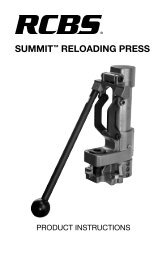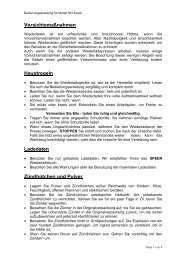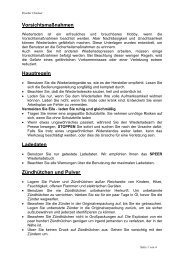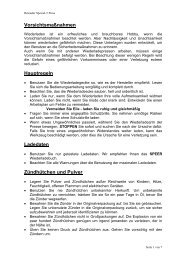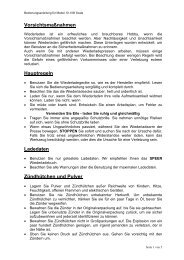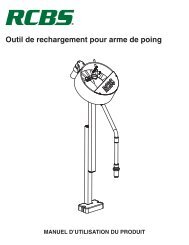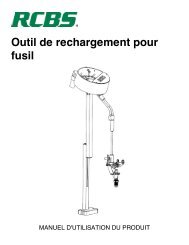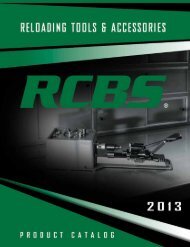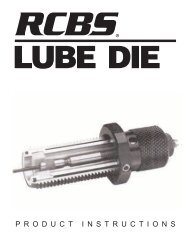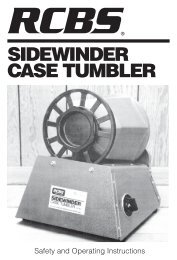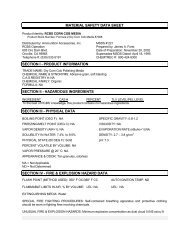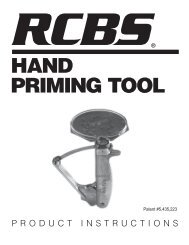AmmoMaster® Chronograph Operating Instructions ... - RCBS
AmmoMaster® Chronograph Operating Instructions ... - RCBS
AmmoMaster® Chronograph Operating Instructions ... - RCBS
You also want an ePaper? Increase the reach of your titles
YUMPU automatically turns print PDFs into web optimized ePapers that Google loves.
ecorded velocities (see Figure 16). Depressing “Enter” again, or<br />
the “Add Data” button, the display will flash between “String” 4 and<br />
“Ready” on “Shot” 1. Now the unit is ready to record shot 1 in string 4.<br />
Figure 16 - Display for No Data in String<br />
SKYSCREEENS<br />
your AmmoMaster ® Skyscreens operate using standard photocell<br />
technology. The photocell is constantly gathering incoming light. When<br />
an instantaneous change in light is detected, the photocell saves the<br />
time at which this occurs. For example, when a projectile is fired over the<br />
Start Skyscreen of the <strong>Chronograph</strong>, the shadow cast by the projectile<br />
triggers the photocell at a moment in time. The instant the projectile<br />
passes over the Stop Skyscreen, the shadow cast by the projectile<br />
triggers the photocell at another moment in time, thus generating a<br />
start and stop time. Since the Skyscreens are manufactured with a<br />
known distance between them, the projectile velocity can be calculated<br />
using the equation Velocity = Distance ÷ Time.<br />
DIFFUSERS<br />
The diffusers for your AmmoMaster ® <strong>Chronograph</strong> play a very important<br />
role in recording velocity readings. The diffusers are used to help<br />
filter out any unnecessary incoming light. This aids in the photocell’s<br />
ability to detect a slight change in light as a projectile passes over<br />
the Skyscreen. if the diffusers are not used on a clear, sunny day, the<br />
photocell may be saturated by all the incoming light and may not detect<br />
the shadow cast by the projectile. imagine trying to spot an object flying<br />
through the air as it passes directly in front of the sun; this is similar<br />
to using the chronograph without any diffusers on a clear sunny day.<br />
Again, imagine trying to spot the same object flying through the air as<br />
it passes directly in front of the sun but this time, there is an overcast<br />
condition. The object is much easier to see. This analogy is similar to<br />
using diffusers on your <strong>Chronograph</strong>.<br />
LIGHTING CONDITIONS<br />
now that you have a basic understanding of what makes your<br />
chronograph function, you know that the lighting conditions are<br />
very important. A Skyscreen’s accuracy and sensitivity to changes in<br />
illumination is based on the ambient lighting conditions. While they<br />
work most of the time, chronographs do have limitations which will<br />
cause errors. Too much light, as well as not enough light, will inhibit the<br />
chronograph operation.<br />
in low light situations, i.e., early morning, late evening, overcast or<br />
cloudy conditions, the chronograph may produce inconsistent velocity<br />
measurements or may not record velocity readings at all. Try removing<br />
the diffusers to allow more light to reach the photocell.<br />
problems can also arise on clear, sunny days when shooting over snow,<br />
water, or light colored sand/gravel, etc. Reflected light off the ground<br />
can illuminate the bottom of the bullet and cancel the shadow cast onto<br />
the skyscreen causing erroneous velocity readings. When this happens,<br />
try covering the ground around the chronograph with a blanket or nonreflective<br />
tarp. This should minimize the reflected ground light and<br />
alleviate the problem. Another technique is to color the bullet with a<br />
black marker, especially if the bullets have a shiny appearance.<br />
in locations with direct overhead sunlight, the Skyscreen may become<br />
saturated by the incoming light, even when the diffusers are installed.<br />
Excessive light can cause a blind condition and the photocell may not<br />
“see” the bullet pass over. This is because the small bullet’s shadow<br />
is not providing sufficient contrast. To reduce the amount of input light,<br />
try covering the diffuser’s top surface with any material that will absorb<br />
or reflect the light (aluminum foil, cloth material, cardboard, etc.) Don’t<br />
use anything heavy enough to disrupt the units balance or damage the<br />
diffuser or Side Supports. if all else fails, it might be best to come back<br />
and shoot another day or wait until later in the day when the light has<br />
subsided.<br />
INDOOR SHOOTING<br />
To use indoors, you must provide the chronograph with an artificial light<br />
source. Install a standard incandescent light bulb centered 24 inches<br />
above each diffuser to provide a uniform illumination. We recommend<br />
using a 60 – 100 W bulb and an aluminum reflector dish for each<br />
light fixture, if possible. These products are readily available at most<br />
hardware stores.<br />
Other lighting configurations may provide acceptable results (different<br />
installation height, no reflector dish, etc.), but be slightly less accurate.<br />
fluorescent light sources will not work reliably because they do not<br />
provide a continuous light source.<br />
SHOTSHELL VELOCITY<br />
it is highly recommended that you determine your shot’s pattern<br />
size before starting. Only use your Diffusers and Side Supports if your<br />
gun’s shot pattern is small enough to pass through the chronograph’s<br />
shooting area without causing damage. fAiluRe To do So MAy CAuSe<br />
SeRiouS dAMAge To The SkySCReen oR oTheR CoMponenTS And<br />
poTenTiAlly CAuSe SeRiouS inJuRy To The ShooTeR.<br />
To prevent damage to your <strong>Chronograph</strong>, we recommend removing<br />
the diffusers and Side Supports when measuring shotshell velocity.<br />
Position weapon 10 feet away from chronograph (see Figure 9) and<br />
continue using as you would for centerfire rifle ammo. Certain ambient<br />
and environmental conditions can result in erratic measurements when<br />
the diffusers are not used. See “lighting Conditions” section for more<br />
information.<br />
To measure your shot pattern, place a paper target approximately 15<br />
feet from the muzzle of your firing position. Shoot into the target to<br />
measure the diameter of the shot pattern. Then, determine a desired<br />
aiming point to ensure you are shooting approximately 4-6 inches<br />
above the chronograph Skyscreens. once this has been done place<br />
your chronograph so the back of the unit is against the target. Verify<br />
the shot pattern is the correct height above the skyscreens. Move the<br />
target a few feet further away (ie., down range) from the chronograph<br />
and begin recording velocities.<br />
ARROW VELOCITY<br />
for better measurement accuracy, make sure you are far enough away from<br />
the chronograph so that the arrow separates completely from the bow string<br />
before the tip reaches the “Start” skyscreen. Blunt arrow tips work best.<br />
STATISTICAL DATA<br />
Statistical data only applies to the recorded data within a selected shot<br />
string, not multiple strings. Therefore, the largest sample size for any<br />
statistical data measurement will be a sample size of ten.<br />
High Velocity<br />
displays highest recorded velocity within selected shot string.<br />
Low Velocity<br />
displays lowest recorded velocity within selected shot string.<br />
<strong>RCBS</strong> AmmoMaster ® <strong>Chronograph</strong> <strong>Instructions</strong> 7



